Per- and Polyfluoroalkyl Substances : PFAS: New bill wants to protect waste and compost industry from liability claims

PFAS have become a household name in the US in recent years. The acronym stands for per- and polyfluoroalkyl substances. They are a group of human-made chemicals that have been widely used in various industries since the 1940s due to their unique properties. PFAS are resistant to heat, water, and oil, making them valuable for applications like non-stick cookware, water-repellent fabrics, firefighting foams, and food packaging materials.
One of the key characteristics of PFAS is their persistence in the environment – and the human body. They do not break down easily and can accumulate over time. Therefore, they are nicknamed “forever chemicals”. Some PFAS, such as perfluorooctanoic acid (PFOA) and perfluorooctane sulfonate (PFOS), have been detected in the environment, wildlife, and human populations globally.
There is concern about the potential health effects of PFAS exposure. Research suggests that certain PFAS may be associated with adverse health outcomes, including reproductive and developmental problems, liver and kidney damage, immune system effects, and an increased risk of certain cancers. However, the full extent of their impact on health is still the subject of research.
Stay connected - subscribe to our newsletters!
Regulations for PFAS
Due to their persistence and potential health risks, there is increasing concern about PFAS contamination in water supplies, soil and food. There have been efforts to reduce the use of PFAS in various industries and to regulate their presence in the environment and in consumer products. Numerous countries and jurisdictions have implemented regulations or guidelines to limit the use of PFAS and set standards for their presence in drinking water and other media.
The US Environmental Protection Agency (EPA) intends to list PFOS and PFOA as hazardous substances under the Comprehensive Environmental Response, Compensation and Liability Act (CERCLA), also known as Superfund. This has on the one hand led to criticism of the chemical industry.
“We support strong, science-based regulations that are protective of public health and the environment, but a new proposed CERCLA listing is an expensive, ineffective and unworkable means to achieve remediation for these chemicals,” the American Chemistry Council (ACC) said in a statement back in November 2022. “This proposal would result in potentially significant economic impacts but will not provide additional information on releases or facilitate timely cleanup of sites contaminated with the two substances. The magnitude of these impacts will be determined by the outcome of the Agency’s ongoing efforts to develop drinking water standards for the substances and to provide clear guidance on appropriate disposal and destruction methods.
EPA should not move forward with the proposal until it has established an appropriate cleanup level based on the best available science and the Agency has determined that sufficient capacity exists for the disposal of PFOA and PFOS wastes.American Chemistry Council (ACC)
“EPA should not move forward with the proposal until it has established an appropriate cleanup level based on the best available science and the Agency has determined that sufficient capacity exists for the disposal of PFOA and PFOS wastes.”
On the other hand, the EPA proposal has also led to serious concern within the waste management industry. Seeing itself a "passive recipient" of PFAS-containing materials the industry fears the EPA's decision could have costly unforeseeable consequences. Therefore, waste, recycling, composting and water treatment businesses have been asking Congress to intervene on their behalf for several months. They fear that the anticipated CERCLA designation - which has yet to take effect and is expected to be finalised later this year - may expose them to expensive lawsuits, cost them millions in sorting and processing costs, or hamper their ability to safely manage materials by forcing them to reject items containing PFAS. At a congressional briefing back in March, groups such as the Solid Waste Association of North America (SWANA), the National Waste & Recycling Association (NWRA) and the U.S. Composting Council (USCC) called for a specific exemption from CERCLA.
Related article: Bioplastics and Composting: Not a love match
New bill aims to protect waste industry
It seems that some legislators were listening. At the beginning if May, a proposed legislation was introduced in Congress that would protect some solid waste management and composting facilities from liability claims if the EPA designates certain PFAS compounds as hazardous substances. The Resource Management PFAS Liability Protection Act, sponsored by Sen. Cynthia Lummis, seeks to exclude composters and solid waste facility operators from liability for certain "costs and damages" associated with the release of certain PFAS into the environment.
The bill affects owners and operators of covered composting operations and solid waste management facilities including landfills and transfer stations, as well as other facilities defined in the Solid Waste Disposal Act. These operations would still have to comply with the necessary permitting requirements and wouldn't be protected if they were found to be "grossly negligent or intentionally negligent in the discharge, disposal, management, processing, transportation or storage" of PFAS.

“There is no doubt we need to consider the environmental impacts of PFAS chemicals but suing entities who did not contribute to the contamination is overkill,” Sen. Lummis said in a statement.
The Resource Management PFAS Bill is part of a series of five bills, each of which is designed to protect specific industries from unintended liability or unintended costs.
There is no doubt we need to consider the environmental impacts of PFAS chemicals but suing entities who did not contribute to the contamination is overkill.Sen. Cynthia Lummis
EPA plans more separate standards
In addition, the EPA is currently considering separate PFAS standards for drinking water, which could result in a final rule by the end of the year, and is conducting other PFAS-related studies outlined in the agency's long-term PFAS Roadmap plan, presented in 2021.
In Europe PFAS still fly a bit under the radar. But countries like Germany, the Netherlands, Denmark, Norway and Sweden have signalled their intention to ban the manufacture of PFAS, most of their uses and their placement on the EU market.
Interview PFAS in Composting Facilities
Linda Norris-Waldt, Deputy Director and Director, Advocacy, Corporate & Chapter Relations of the US Composting Council (USCC) talks about the current situation of PFAS in composting facilities.
What are PFAS and why are they a problem for the composting industry?
PFAS is a family of chemical compounds that numbers in the thousands that are ubiquitous in the modern environment. They’re usually found at low concentrations that are reported in the parts trillion (for liquids like water and leachate) and parts per billion (for solid material such as soil and compost).
How are they managed so far in composting facilities?
We are considered passive receivers of PFAS chemicals, and as such, we don’t ask for them, intentionally put them in and certainly can’t refuse them because of their ubiquity. They are in all of our feedstocks, from biosolids to food waste; they are in contamination that comes in such as non-compostable food packaging; they come in through rainwater, air emissions and from upstream industrial neighbors. There are no easy or cost-effective ways to test for them or to dispense of or break them down.

What is the current status of research regarding PFAS?
Research regarding compost and soils is behind in terms of the US investment in research for PFAS chemicals in water. This is difficult for the compost industry because state legislatures and regulators are under pressure to regulate, but the science isn’t available to know how much and if these compounds are “taken up” by the kinds of crops on which compost is most used. That means regulating “in the dark” so to speak. The USCC has been advocating for USDA to fund research studies into this because compost is so beneficial for crops, nutrients and plant organic matter; removing the ability to use compost in a data vacuum could do great harm to the benefits compost brings as well to climate through reduction of methane in landfills from organics and sequestration of carbon in the compost use/plant use, as well as seriously damage our industry.
What are the current regulations and what does the EPA plan in the future?
As mentioned, current regulations are state-by-state. The most severe has been shutdown of biosolids compost on farms in Maine; Colorado is now requiring testing biosolids compost; others have varying levels of tolerance (again, not based on any available science) for amounts of the compound in compost. Many others have taken a wait and see approach as EPA does a health risk assessment, expected by the end of 2023 or early 2024, of risk tolerance in the human body.
EPA has proposed a Comprehensive Environmental Response, Compensation and Liability Act enforcement ruling (also known as Superfund) for addressing PFAS contamination that would currently bring compost facilities under its jurisdiction. While some at EPA have indicated they might not use CERCLA in some situations, there is no guarantee of that, and without protection, private parties can come after compost facilities, even though we do not import, produce or require PFAS in our product. Sen. Cynthia Lummis has introduced the Resource Management PFAS Liability Relief Act, which we hope will pass so that the environmentally beneficial compost industry will be exempt.
Research regarding compost and soils is behind in terms of the US investment in research for PFAS chemicals in water. This is difficult for the compost industry because state legislatures and regulators are under pressure to regulate, but the science isn’t available to know how much and if these compounds are “taken up” by the kinds of crops on which compost is most used.Linda Norris-Waldt, USCC
Are the regulatory efforts sufficient?
Without the science behind how much plants carry along PFAS as a pathway to humans and what levels in humans are dangerous, it is difficult to know if EPA’s proposals are adequate or more than is needed. The science should have been gathered years ago, but at least it is now underway in some quarters; meanwhile, we have supported legislative efforts to have the manufacture and intentional use of PFAS banned.
The USCC will host a webinar on PFAS and compost research on May 24th. You can register here.


